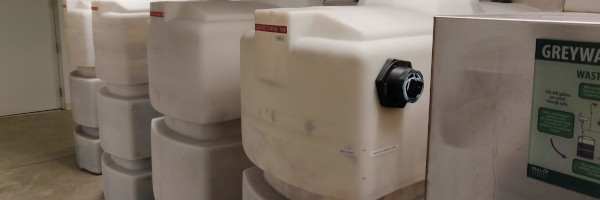Utility
| Utility | ||||||||||||||||||||||||||||||||
|---|---|---|---|---|---|---|---|---|---|---|---|---|---|---|---|---|---|---|---|---|---|---|---|---|---|---|---|---|---|---|---|---|

| ||||||||||||||||||||||||||||||||
| Introduction | ||||||||||||||||||||||||||||||||
| Contact | Pete Tseronis | |||||||||||||||||||||||||||||||
| Topics | ||||||||||||||||||||||||||||||||
NEWS
REPORTS
| ||||||||||||||||||||||||||||||||
- Authors
The Utility SuperCluster theme on sustainability originated from an earlier technology demonstration at GCTC in 2015 called Smart Cities Optimized Action Cluster. The action cluster worked with the Las Vegas Valley Water District on Water Infrastructure Management and Leak Detection and was deployed successfully in three metropolitan cities in the United States.
With the focus on sustainability, the team wanted to raise awareness of the issue around water infrastructure management. Especially the fact that approximately 20-30% of a utility’s water is lost in the network of pipes comprising their transmission and distribution system. This results in a staggeringly high global annual water loss of $14 billion. In the United States, this translates to 700 water main breaks per day or 250,000 annually for a typical water pipe leaking about 400,000 gallons of water per year. This also means nearly 9,000 kWh of energy are wasted annually.
This is a significant problem since for most utilities, buried water pipelines represent the largest value asset within their system and typically carry replacement costs in excess of $1,000,000 per mile. While looking for hard to find distribution and transmission leaks in water systems isn’t new, the means now being used is: Internet of Things (IoT) technologies.
For example, with the evolution of cellular LTE, sensors and analytics, Mueller Water Products had commercially developed the EchoShore-TX permanent leak detection solution to collect, transmit and manage data. The monitoring platform combines acoustic leak detection technology with LTE cellular wireless connectivity and visual end-user dashboards to create a cost-effective monitoring solution. As a result, Las Vegas initially deployed 13 permanent acoustic sensors monitoring 4 miles of the aging pipeline installed under Las Vegas Boulevard, from Sunset to Flamingo Roads, which resulted in the capability to monitor the transmission pipe continually for problems and leaks.
This project concluded that aging water infrastructure challenges will continue to escalate as buried pipelines throughout the nation near the end of their useful life, resulting in water loss, inefficient use of energy and property damage. Simply replacing or allowing these assets to run to failure is cost- prohibitive and not a sustainable infrastructure management approach. New pipeline monitoring technology combined with wireless communications and data visualization as demonstrated in the NIST Global City Teams Challenge are enabling utilities to cost-effectively gather more data to make more informed decisions. This directly leads to extended asset life, reduced operating risks and better management of water as a resource.
After the conclusion of the project, GCTC decided to bring together all other utility centric projects into one Utilities SuperCluster.
With the clustering of utility centric projects in 2015, the Utility SuperCluster was established at the annual GCTC fall meeting with contributions from 38 attendees comprising of individuals from government agencies, cities, universities, an international embassy, non-profit organizations and global technology and consulting providers. Since 2015, the Utility SuperCluster group has expanded to over 125 members in 18 action cluster projects.
The Utility SuperCluster
The purpose of the Utility SuperCluster is to address leading Energy, Water and Waste sustainability issues in cities by demonstrating real world examples and best practices. To do so, it brings together US and global communities along with academia and technology partners. The SuperCluster is segmented into three groups with each group managed by its own working group co-chair. The Energy, Water and Waste working groups are responsible for managing active projects and developing high-level blueprints of replicable, scalable and sustainable solutions based on successful real-world examples and best practices. The goal is for this blueprint to be utilized by cities around the world as a way to jumpstart their efforts to create their own IoT-based technology roadmap.
High Level Purpose
In collaboration with the utility work session attendees, the group agreed to develop a high-level purpose that would serve as an overarching guide for adoption and acceleration of IoT technologies. Specifically, the group’s aim is to address leading sustainability issues that impact cities by including academia and technology partners in solutions for the consumption side (reduced) and production side (increased), with focus on sustainability of energy, water, and waste.
Goals and Objectives
The main goals and objectives include saving energy and water to benefit cities and regions through innovative technologies by:
- Identifying new collaborative commons for energy, water and waste “clean tech” technologies
- Share finance and business models that work for both production and consumption
- Focus on solutions that account for water, increase conservation and increase energy production
- Highlight improvements and innovations for new technologies that save energy, water and
money while growing the economy and protecting the environment
- Empowering citizens to be prosumers and consumers
Strategies and Approaches
With the creation of the SuperCluster, the group members were segmented into three vertical focused groups with each as a sub group for Energy, Water and Waste lead by a co-chair. The Utility SuperCluster is managed by Ed Davalos of Motorola Solutions as the working group chair with the following industry segment co chairs: Ken Thompson from CH2M managing Water; Deborah Acosta from the City of San Leandro and Derek Lee from PilotCity co-managing Energy; and Scott Pomeroy from Scalable Strategies managing Waste. In order to align on a common approach and to develop a best practice framework, it was agreed to use a simple format capturing a problem statement, the cause of the problem, proposed solutions, benefits from the solution and a summary of a blueprint. In developing the strategy and approaches, consideration was given to:
- Assessing the benefits and publishing findings (both tangible and intangible, what’s tangible in future and other benefits like productivity)
- Developing social systems to track benefits
- Supporing communication and education
- Developingt and using IoT kits in K-12 education
- Determining how to leverage other industry groups to replicate/scale solutions
- Determining strategies for growth
- Parallel partnering opportunities, such as IEEE, American Water Works Association, American Society of Civil Engineers, EPRI, ACORE, ACEEE and other large industry associations
- Establishing regional groups and national hubs as the working group matures
- Creating a framework to address funding and finance issues
Addtional Organizational Considerations
With the three sub groups for Energy, Water and Waste created and organized, consideration was given to development of a Collaboration Plan, including adding city sustainability manager and networking groups to expand collaboration.
Consideration was also given to establishing Targets and Metrics, such as the templated Key Performance Indicator (KPIs) to measure program success based on life cycle cost reduction, GHG emission reduction, productivity improvements and customer satisfaction.
Founding Participants
The Utility SuperCluster working group was formed at NIST GCTC’s fall summit in 2015 with contribution of the following cities.
List of Founding Participants
| Cities and Government | ||||
|---|---|---|---|---|
| Gwinnett County,GA | Washington, DC | U of Vermont | Downtown DC BID | Burkina Faso, Niger |
| Charlotte, NC | Burlington, VT | Winooski, VT | Suraj Energy | Goyang City Korea |
| Spokane, WA | Chattanooga, TN | Metro Council of Gov’t Republic of Congo | U.S. Dept. of Commerce | Dallas, TX |
| San Diego, CA | Goyang, South Korea | City of Chula Vista UT at Chattanooga | Loudoun Water City of KC MO | Embassy of Italy |
| Georgia Tech | City of Bellevue | Montgomery County MD | Ghana, Benin, Togo | NIST/Santa Clara University |
| Downtown DC | BID/Washington DC | City of San Leandro, CA | ||
| Consultants and Technology Providers | ||||
|---|---|---|---|---|
| CH2M | Cleanech San Diego | Black & Veatch | Qualcomm | |
| Scalable Solutions | Ingenu | Fiware/InterInnov | Strateq | |
| AT&T | LG | Uplus IoT Dev Labs | SAP | |
| IBM | Phillips | PNNL | McKinsey & Co. | |
| Smart City Capital, LLC | ATIS | Zip Power | Itron | |
Technology and Cross Cutting Elements in IoT
Technology and cross cutting elements in IoT were considered which the group recognized to include IoT Communications, Hardware, Data Analytics and cross industrial and application funding. After evaluating where to best focus the group’s effort, Security and Funding were pursued as two horizontal areas of blueprint framework efforts

![link=[[Media:{{{Release}}}]]](/images/thumb/1/16/Whitehouse.jpg/200px-Whitehouse.jpg)









